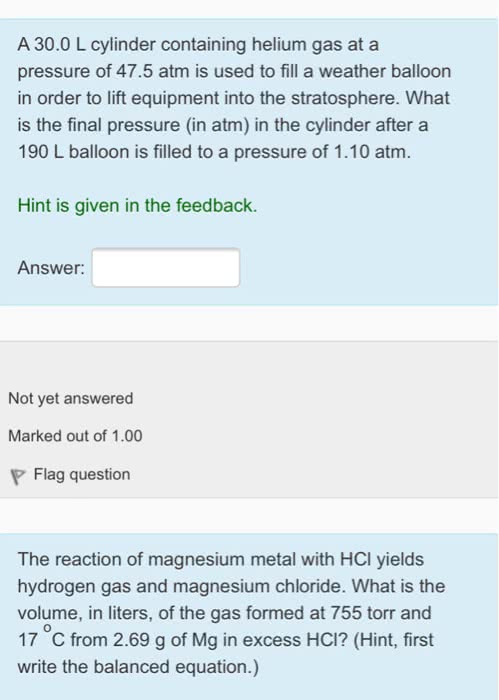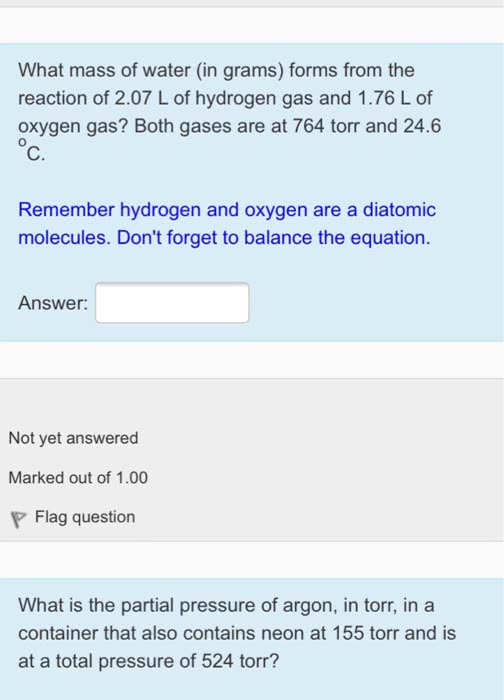1- (A) A 41 L cylinder containing helium gas at a pressure of 46.7 atm is used to fill a weather balloon in order to lift equipment into the stratosphere. To what maximum pressure (in atm) could a 286 L balloon be filled.
(B) A 38.0 L cylinder containing helium gas at a pressure of 20.9 atm is used to fill a weather balloon in order to lift equipment into the stratosphere. What is the final pressure (in atm) in the cylinder after a 169 L balloon is filled to a pressure of 1.15 atm.
(C)The following procedure provides a crude method of determining the molar mass of a volatile liquid. A liquid of mass 0.0181 g is introduced into a syringe and the end is capped (sealed). The syringe is transferred to a temperature bath maintained at 59.4 oC, and the liquid vaporizes. As the liquid vaporizes the plunger is pushed out. At equilibrium, the plunger reads 6.61 mL of gas. Atmospheric pressure is 740. mmHg. What is the approximate molar mass of the compound (in g/mol)?
(D)The reaction of magnesium metal with HCl yields hydrogen gas and magnesium chloride. What is the volume, in liters, of the gas formed at 757 torr and 34 oC from 4.59 g of Mg in excess Hal?
(E)What mass of water (in grams) forms from the reaction of 2.60 L of hydrogen gas and 1.97 L of oxygen gas? Both gases are at 698 torr and 12.9 oC.
(F)What is the partial pressure of argon, in torr, in a container that also contains neon at 220 torr and is at a total pressure of 439 torr?
(G)What is the total pressure if a container contains 10 torr of He gas, 207 torr of N2 gas, and 72 torr of Ar gas?
(H)Oxygen gas is collected over water. The total pressure (the O2 pressure + the water vapor pressure) is 760 torr. The temperature of the water is such that the water vapor pressure is 49 torr. What is the partial pressure of the oxygen gas in torr?
(I)A 5.10 L sample of neon at 10.11 atm is added to a 13.0 L cylinder that contains argon. If the pressure in the cylinder is 7.92 atm after the neon is added, what was the original pressure (in atm) of argon in the cylinder?
(J)Calculate the total pressure, in atm, in a 5 L flask that contains 6.42 g of Ne and 1.55 g of Ar. The temperature of the gases is 32 oC.
(K)Calculate vrms, the root mean square velocity, in m/s of SO2 molecules at 274 oC.
(L)An effusion container is filled with 7 L of an unknown gas. It takes 132 s for the gas to effuse into a vacuum. From the same container under the same conditions--same temperature and initial pressure, it takes 335 s for 7.00 L of O2 gas to effuse. Calculate the molar mass (in grams/mol) of the unknown gas.
(M)Three bulbs are connected by tubing, and the tubing is evacuated. The volume of the tubing is 28.0 mL. The first bulb has a volume of 83.0 mL and contains 5.10 atm of argon, the second bulb has a volume of 250 mL and contains 1.09 atm of neon, and the third bulb has a volume of 33.0 mL and contains 4.04 atm of hydrogen. If the stopcocks (valves) that isolate all three bulbs are opened, what is the final pressure of the whole system in atm?
(N)Use the van der Waals equation to calculate the pressure, in atm, of 45.61 mol of hydrogen at 443 oC in a 2.45 L container.
1- (A) A 41 L cylinder containing helium gas at a pressure of 46.7 atm is used to fill a weather balloon in order to lift equipment into the stratosphere. To what maximum pressure (in atm) could a 286 L balloon be filled.
(B) A 38.0 L cylinder containing helium gas at a pressure of 20.9 atm is used to fill a weather balloon in order to lift equipment into the stratosphere. What is the final pressure (in atm) in the cylinder after a 169 L balloon is filled to a pressure of 1.15 atm.
(C)The following procedure provides a crude method of determining the molar mass of a volatile liquid. A liquid of mass 0.0181 g is introduced into a syringe and the end is capped (sealed). The syringe is transferred to a temperature bath maintained at 59.4 oC, and the liquid vaporizes. As the liquid vaporizes the plunger is pushed out. At equilibrium, the plunger reads 6.61 mL of gas. Atmospheric pressure is 740. mmHg. What is the approximate molar mass of the compound (in g/mol)?
(D)The reaction of magnesium metal with HCl yields hydrogen gas and magnesium chloride. What is the volume, in liters, of the gas formed at 757 torr and 34 oC from 4.59 g of Mg in excess Hal?
(E)What mass of water (in grams) forms from the reaction of 2.60 L of hydrogen gas and 1.97 L of oxygen gas? Both gases are at 698 torr and 12.9 oC.
(F)What is the partial pressure of argon, in torr, in a container that also contains neon at 220 torr and is at a total pressure of 439 torr?
(G)What is the total pressure if a container contains 10 torr of He gas, 207 torr of N2 gas, and 72 torr of Ar gas?
(H)Oxygen gas is collected over water. The total pressure (the O2 pressure + the water vapor pressure) is 760 torr. The temperature of the water is such that the water vapor pressure is 49 torr. What is the partial pressure of the oxygen gas in torr?
(I)A 5.10 L sample of neon at 10.11 atm is added to a 13.0 L cylinder that contains argon. If the pressure in the cylinder is 7.92 atm after the neon is added, what was the original pressure (in atm) of argon in the cylinder?
(J)Calculate the total pressure, in atm, in a 5 L flask that contains 6.42 g of Ne and 1.55 g of Ar. The temperature of the gases is 32 oC.
(K)Calculate vrms, the root mean square velocity, in m/s of SO2 molecules at 274 oC.
(L)An effusion container is filled with 7 L of an unknown gas. It takes 132 s for the gas to effuse into a vacuum. From the same container under the same conditions--same temperature and initial pressure, it takes 335 s for 7.00 L of O2 gas to effuse. Calculate the molar mass (in grams/mol) of the unknown gas.
(M)Three bulbs are connected by tubing, and the tubing is evacuated. The volume of the tubing is 28.0 mL. The first bulb has a volume of 83.0 mL and contains 5.10 atm of argon, the second bulb has a volume of 250 mL and contains 1.09 atm of neon, and the third bulb has a volume of 33.0 mL and contains 4.04 atm of hydrogen. If the stopcocks (valves) that isolate all three bulbs are opened, what is the final pressure of the whole system in atm?
(N)Use the van der Waals equation to calculate the pressure, in atm, of 45.61 mol of hydrogen at 443 oC in a 2.45 L container.



